Palinuro is a small seaside resort in the southern Italian region of Campania. This stretch of Italy’s coastline is generally overlooked by foreign tourists, as it lies between the more popular Amalfi Coast to the north and Calabria to the south. Despite some drab modern developments, though, the coastline around Palinuro is lovely, and the sea is clean and inviting. Many Italian families head to the area each year for their summer holidays.
- Find hotels, B&Bs and apartments in and around Palinuro
- My review of the Best Western Hotel La Conchiglia
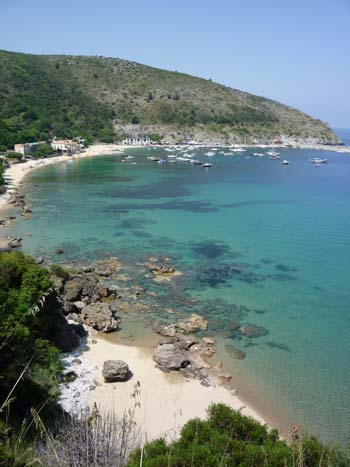
About Palinuro
Palinuro is located on the Tyrrhenian coast, where the Cilento National Park meets the sea. The most famous feature of this stretch of coastline is Capo Palinuro, an imposing headland above the town’s harbour. The name Palinuro is said to be taken from the myth of Aeneas, whose helmsman, Palinurus, is supposedly buried here.
The area around Palinuro has a long history, but the present-day resort has grown up in the last few decades – in one case you can see where the street has been built through an old olive grove. The buildings are low-rise, the lanes are leafy and the atmosphere is relaxed, but there’s no denying that Palinuro lacks the historic charm of a typical Italian village. The main piazza is fairly small and used for car-parking, and the church is modern rather than ancient. Another fact which may put off some tourists is that the settlement is on a slope above sea level, with no promenade. However, the town is a pleasant place, with an amiable and unpretentious holiday atmosphere. It is around a 20-minute walk to nice beaches in either direction from the town centre, and some local hotels have their own stretch of seafront.
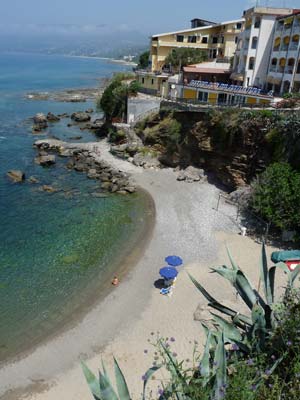
Since it is most popular with Italian tourists, the traditional holiday months of July and August are when the area is at its busiest. Outside these months you’ll find a much quieter atmosphere and cheaper accommodation.
Palinuro tourist information
The most useful tourist information I found in Palinuro was at a travel agency near the roundabout at the start of town, where you can also book train tickets and excursions. This is a good place to start planning your holiday once you’ve arrived in Palinuro. The agency is called Cilento Viaggi and is located at Via Acqua dell’Olmo, 248. Palinuro does have a tourist information office in the central piazza, but when I visited the opening hours were limited and unreliable. Useful bus timetables were pinned to the door, but otherwise the office offered only very basic information; not even a decent town map.
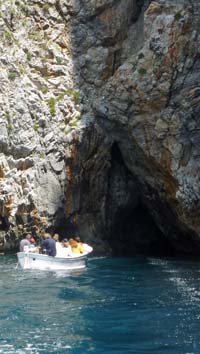
Things to do in and around Palinuro
Palinuro’s principal tourist attraction is a boat ride around Capo Palinuro, visiting caves. The harbour is around a 15-20 minute walk from the village, down a quiet road. The harbour, used by small fishing and pleasure boats, nestles into the side of the headland. There are a couple of places to eat, a beach and a kiosk selling tickets for boat tours. The small boats set off frequently – pretty much on demand – and cruise along the cliffs of Capo Palinuro. Several caves can be visited, each of which has its own special attraction – a ‘blue’ cave, a ‘blood’ grotto and so on. They’re reasonably impressive and the outing is good fun.
Although the town itself isn’t right on the sea, there are some good beaches in and around Palinuro. Down by the harbour is a nice beach with a picturesque though not-terribly-good restaurant terrace alongside. On the far side of the headland are a couple of pretty coves. It would require some energy to access these on foot, but the boat tour stopped off here for 20 minutes – you could arrange simply to be dropped off and collected later. You can swim or paddle in beautifully clear water, with tiny fish swimming around your feet; a really idyllic spot.
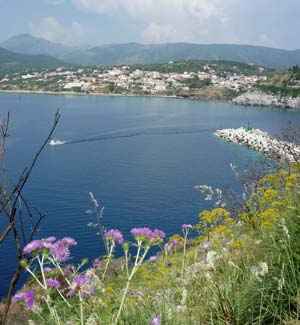
On the slopes between the harbour and the ridge running out to the headland there are some stretches of woodland nature walk. It is also possible to walk out to the lighthouse crowning the promontory, though the walk is not particularly panoramic and the lighthouse is a fenced-off military zone. Various ruined forts are dotted along the headland, and would make a good tourist attraction if they were cleared and opened with footpaths. One which can be reached is just above the harbour; a pleasant contoured path runs along through flowers to a ruined defensive tower with great views of the coastline and town.
Palinuro has a small museum set in a dusty little park above the sea. It contains information boards about the area’s history (in Italian) and displays of grave-goods found in the local area, mostly from a necropolis related to the Greek and Roman site at Molpa. Molpa is now a cluster of ruins on an abandoned hill; it’s possible to walk there from Palinuro, though there isn’t a lot to see.
The rest of Palinuro is quickly explored; just a few parallel streets dotted with restaurants, cafes and a few souvenir shops. Above town, the road climbs to form a loop on the headland where larger villas – some of which are dated architectural curiosities – are dispersed among woodland, and a picturesque old farm settlement provides the local colour lacking in the centre of town.
For an active holiday, visitors can explore Capo Palinuro by kayak or on diving excursions. Palinuro Sub Diving Center, located on the road to the port, hires out equipment and also offers tours and accompanied dives.
Palinuro beaches
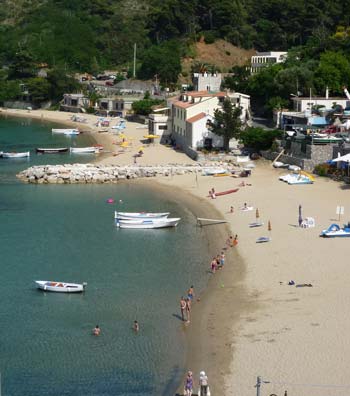
As described above, there is a pleasant beach next to Palinuro’s little harbour, down a sloping road from town, and a tiny beach (also pictured) below the heart of the town. Up the coast, in the opposite direction from the harbour, there are longer stretches of beach which can be reached on foot (a longer walk), by car, or from nearby campsites and accommodation. To reach these beaches (called Le Saline) on foot, you can take the lane leading downhill from the roundabout at the edge of town. Walking, driving, or taking a boat to the far side of the Capo Palinuro headland, you’ll come to the pretty beach of La Marinella, which faces south. Further down the coast are more long stretches of beach, heading towards Marina di Camerota. From the harbour in Palinuro you catch a ‘beach shuttle’ ferry service to enjoy bathing in an unspoilt cove.
Further afield: excursions and explorations
Palinuro is a fairly modern settlement; for a taste of history, head a short distance into the hills to Centola. This picturesque hilltown overlooking the sea is the administrative ‘comune’ for the Palinuro area, and is connected to Palinuro by bus. Further inland is one of Italy’s atmospheric ‘ghost towns’, the abandoned village of San Severino (also called San Severino di Centola). San Severino is very near Centola railway station which, perversely, is several miles from Centola.
If you are interested in history, you should make an effort to visit the archaeological site of Velia. This was once a Greek and then Roman town (called Elea); the ruins are open to the public. To reach the site from Palinuro is likely to involve awkward changes of public transport; if you don’t have a car it may be best to negotiate for a taxi.
The whole of the Cilento area – a green and hilly national park – merits exploration. This is best achieved by car, although in the height of summer there are tourist bus services. The Greek ruins at Paestum can be visited in a day trip from Palinuro, as can the Certosa di Padula, an impressive monastery listed by UNESCO as part of the Cilento World Heritage Site along with Paestum and Velia. Summer excursions from Palinuro include outings to Paestum, to the Amalfi Coast and to Capri – ask at the tourist information office, travel agency or your hotel for dates and details.
We visited Palinuro on a rail trip through southern Italy, between stops in Paestum and in Maratea. Read more: South to Calabria: a travel itinerary.
Palinuro travel and transport
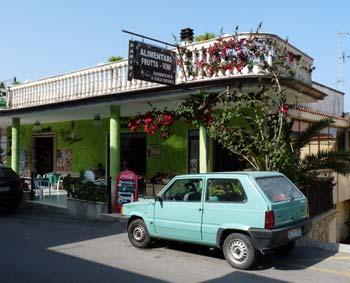
The nearest station to Palinuro is Pisciotta. This is on a railway line which heads south from Naples (a two hour journey) to Reggio di Calabria. Unfortunately the station is 5 miles from Palinuro. There are buses linking the railway station with Palinuro, but services are infrequent and a taxi may be your best option. We were propositioned by a taxi driver at the station, called our hotel to check his price was reasonable and enjoyed a smooth and scenic trip to Palinuro, taking 10-15 minutes. If you are doubtful about connections, or want to book a taxi, call your hotel in advance for advice.
Palinuro is a pretty quiet port these days, but in the summer you may be lucky enough to find a ferry service running, operated by Metrò del Mare, with connections along the Cilento coast and running as far as Naples, sometimes via Capri. Schedules vary so check the website timetable. Note that the port in Palinuro is down a long road from the centre of town, as described above.
There are useful local bus services which connect the harbour, Palinuro centre and Centola, as well as the service which runs to Pisciotta railway station. Timetables are irritatingly hard to research in advance, but are available from the tourist information office in town.
Accommodation
We stayed at the Best Western Hotel La Conchiglia, which is an affordable and practical base in the heart of town.
> My review of the Best Western Hotel La Conchiglia
> More hotels in Palinuro
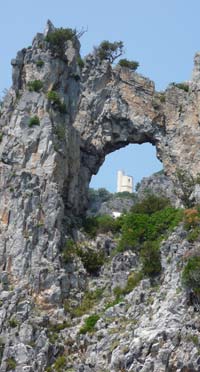
On this site
Best Western Hotel La Conchiglia, Palinuro – review
South to Calabria: a travel itinerary including Palinuro
Useful links
Diving at Capo Palinuro (article from Divernet)